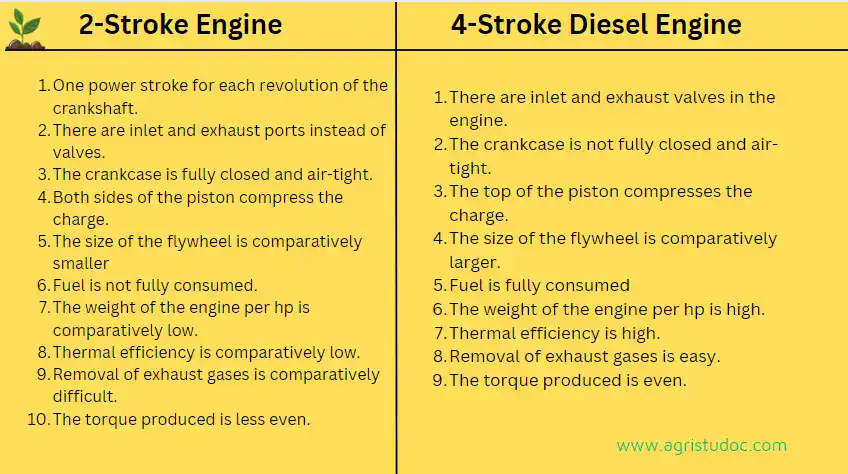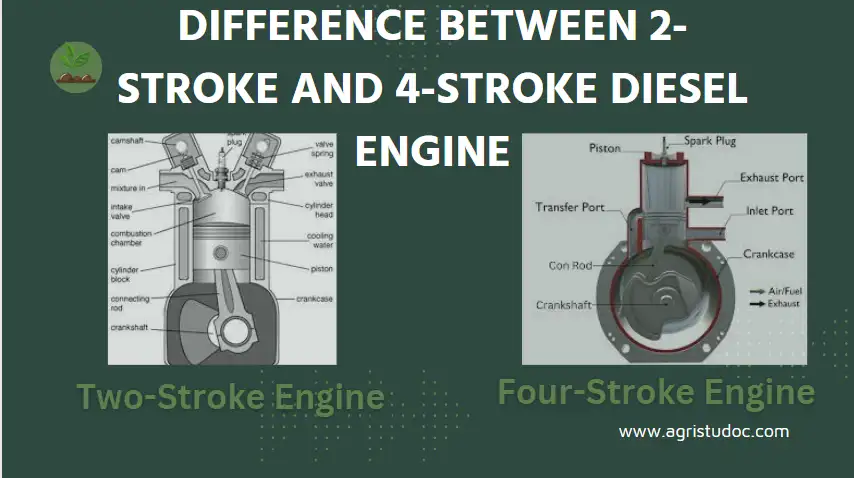In this post, we will discuss all 2-Stroke and 4-Stroke Diesel Engine with their differences, advantages, and disadvantages of both two-stroke and four-stroke engines.
2-Stroke and 4-Stroke Diesel Engine:

When the cycle is completed in one revolution of the crankshaft, it is called a two-stroke cycle engine.
When the cycle is completed in two revolutions of the crankshaft, it is called a four-stroke cycle engine.
Two-Stroke Engine:
In two-stroke cycle engines, the whole sequence of events ie, suction, compression, power, and exhaust are completed in two strokes of the piston (one revolution of the crankshaft).
There is no valve in this type of engine. Gas movement takes place through holes called ports in the cylinder. The crankcase of the engine is airtight in which the crankshaft rotates.
Four-Stroke Engine:
In four-stroke cycle engines the four events namely suction, compression, power, and exhaust take place inside the engine cylinder. The four events are completed in four strokes of the piston (two revolutions of the crankshaft).
This engine has got valves for controlling the inlet of charge and outlet of exhaust gases. The opening and closing of the valve are controlled by cams, fitted on the camshaft. The camshaft is driven by a crankshaft with the help of suitable gears or chains. The camshaft runs at half the speed of the crankshaft.
Difference between 2-stroke and 4-stroke Engine
The main Comparison of 2-Stroke and 4-Stroke Diesel Engine are as given below:
| Two-Stroke Engine | Four-Stroke Engine |
|---|---|
| 1. One power stroke for each revolution of the crankshaft. | 1. One power stroke for every two revolutions of the crankshaft. |
| 2. There are inlet and exhaust ports instead of valves. | 2. There are inlet and exhaust valves in the engine. |
| 3. The crankcase is fully closed and air-tight. | 3. The crankcase is not fully closed and air-tight. |
| 4. Both sides of the piston compress the charge. | 4. The top of the piston compresses the charge. |
| 5. The size of the flywheel is comparatively smaller. | 5. The size of the flywheel is comparatively larger. |
| 6. Fuel is not fully consumed. | 6. Fuel is fully consumed |
| 7. The weight of the engine per hp is comparatively low. | 7. The weight of the engine per hp is high. |
| 8. Thermal efficiency is comparatively low. | 8. Thermal efficiency is high. |
| 9. Removal of exhaust gases is comparatively difficult. | 9. Removal of exhaust gases is easy. |
| 10. The torque produced is less even. | 10. The torque produced is even. |
| 11. For the same weight, a stroke engine gives twice the power that of a stroke engine. | 11. For a given weight, the engine would give only half the power of the two-stroke engine. |
| 12. Mostly high-speed engines are there. | 12. All types of speeds are possible (high and low). |
| 13. It can be operated in both directions (clockwise and counterclockwise). | 13. It can be operated in one direction only. |
Advantages and disadvantages of 2-stroke engine
Advantages of a two-stroke engine:
1.The two-stroke cycle engine boasts twice the number of power strokes compared to a four-stroke cycle engine operating at the same engine speed.
2.For equivalent power output, a two-stroke cycle engine is lighter, more compact, and occupies a smaller floor area.
3.The initial cost of a two-stroke cycle engine is significantly lower than that of a four-stroke cycle engine.
4.The weight of a two-stroke engine is reduced compared to a four-stroke cycle engine due to a lighter flywheel resulting from more uniform torque on the crankshaft.
5.With only two strokes in a cycle, a two-stroke engine saves the work required to overcome friction and exhaust strokes.
6.The construction of a two-stroke engine is simpler due to the absence of mechanical valves and valve gears, reducing initial cost.
7.Reversing a two-stroke engine is easily accomplished with a simple reversing gear mechanism.
8.Starting a two-stroke engine is simpler compared to a four-stroke engine.
9.A two-stroke engine requires less space.
10.A lighter foundation is sufficient for a two-stroke engine.
11.The maintenance cost of a two-stroke engine is lower since it involves fewer components.
Disadvantages of a two-stroke engine:
1.The thermal efficiency of a two-stroke cycle engine is lower than that of a four-stroke cycle engine.
2.The overall efficiency of a two-stroke cycle engine is also inferior to that of a four-stroke cycle engine.
3.A significant drawback of a two-stroke cycle engine is its substantial consumption of lubricating oil, primarily due to its high operating temperature.
Advantages and disadvantages of 4-stroke engine
Advantages of a four-stroke engine:
1.Lower Fuel Consumption:
Four-stroke engines exhibit improved fuel efficiency, contributing to cost savings and environmental sustainability.
2.More Balanced and Refined Operation:
The four-stroke cycle results in smoother and more controlled engine performance, enhancing overall vehicle comfort and drivability.
3.Sufficient Power Even at Lower Speeds:
Four-stroke engines provide adequate power across a broader range of speeds, ensuring reliable performance in various driving conditions.
4.Better Lubrication System:
The design of four-stroke engines allows for a more effective and comprehensive lubrication system, promoting enhanced durability and reduced friction.
5.Low Engine Oil Consumption:
Four-stroke engines typically experience lower oil consumption, contributing to reduced maintenance requirements and costs.
6.Fewer Emissions:
Compared to some 2-Stroke and 4-Stroke Diesel Engine generally produce fewer emissions, contributing to environmental conservation and compliance with emission standards.
7.Better Engine Cooling:
Four-stroke engines often incorporate more sophisticated cooling systems, preventing overheating and maintaining optimal operating temperatures.
8.Longer Service Life:
The design and operational characteristics of four-stroke engines contribute to increased longevity, resulting in extended service intervals and a more durable engine overall.
Disadvantages of a four-stroke engine:
1.Higher Weight:
Four-stroke engines tend to be heavier, impacting the overall weight and efficiency of the vehicle.
2.More Complex Design:
The intricate design of four-stroke engines can lead to increased complexity, potentially affecting maintenance and repair processes.
3.More Expensive Repairs in Case of Failure:
Repairing a malfunctioning four-stroke engine can incur higher costs due to the complexity of its components and systems.
4.Two Revolutions of the Crankshaft and Four Strokes of the Piston Required:
The four-stroke cycle necessitates two full revolutions of the crankshaft and four-piston strokes for a single engine working cycle, potentially affecting efficiency.
Conclusion:
In summary, the difference between 2-stroke and 4-stroke diesel engines lies in their cycle completion and design features. While 2-stroke engines offer simplicity, lighter weight, and cost advantages, they suffer from lower thermal efficiency and higher oil consumption. In contrast, 4-stroke engines provide smoother operation, better fuel efficiency, and reduced emissions but come with drawbacks such as higher weight and complexity. Give some feedback about 2-Stroke and 4-Stroke Diesel Engine in comment section.
Also Read:
Remote sensing: Component, Types & application in Agriculture
Layering Propagation : 5 Types, Advantages & Disadvantages
The Ultimate Guide to Safe Use of Pesticides in Agriculture
Explain the Concept of Consumer Surplus with diagrams
Major Problems Of Organic Farming In India 2023

